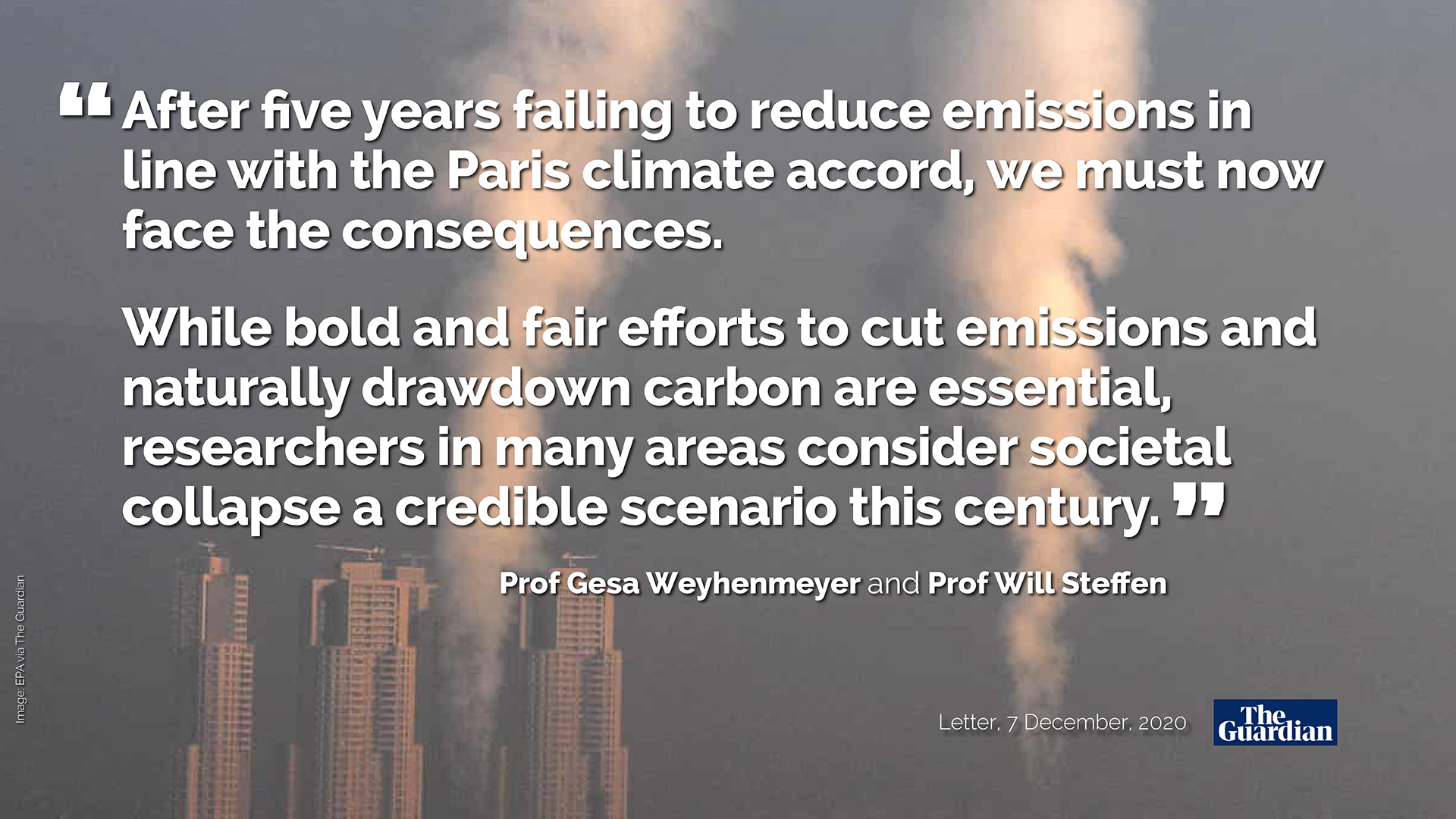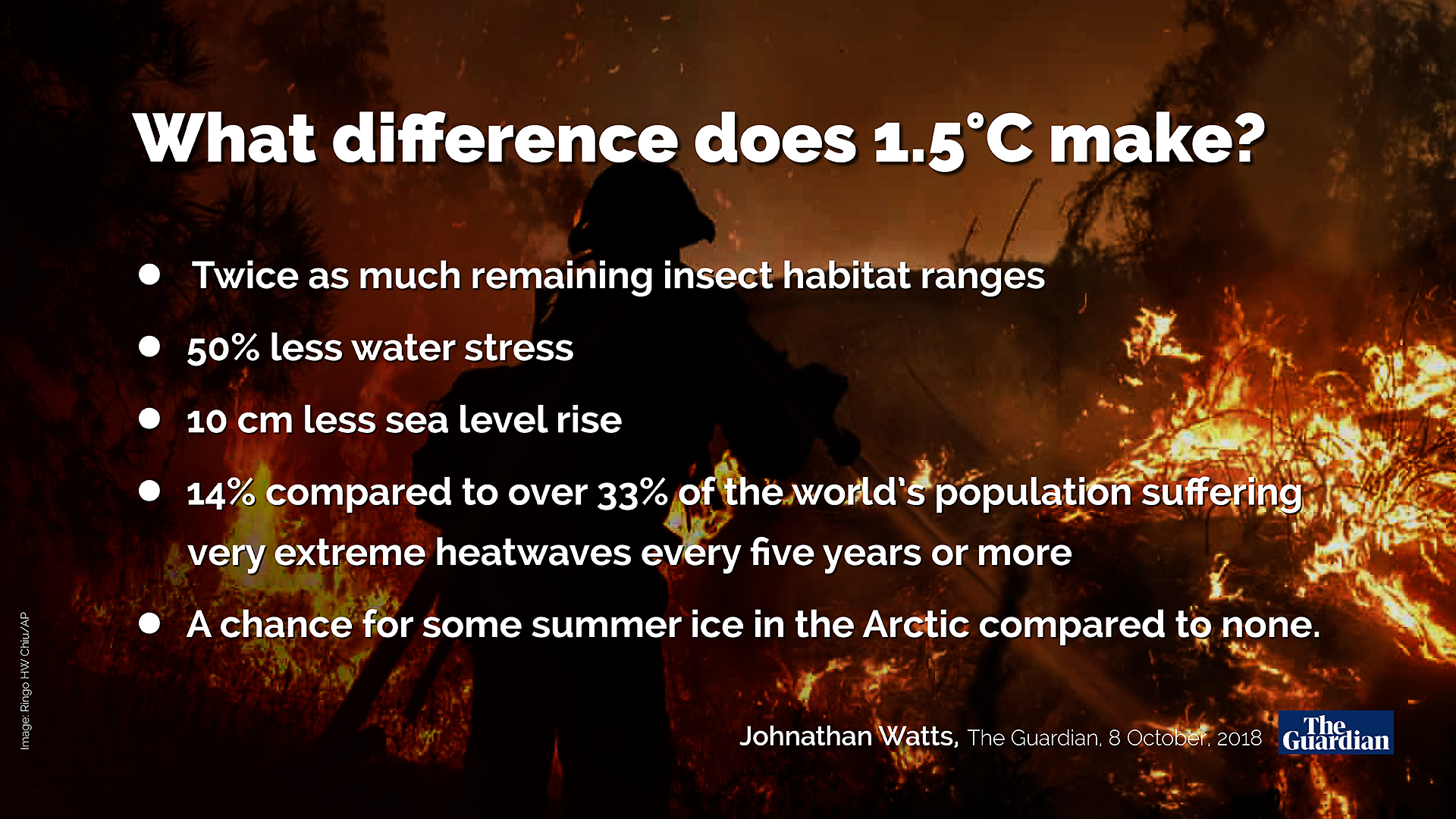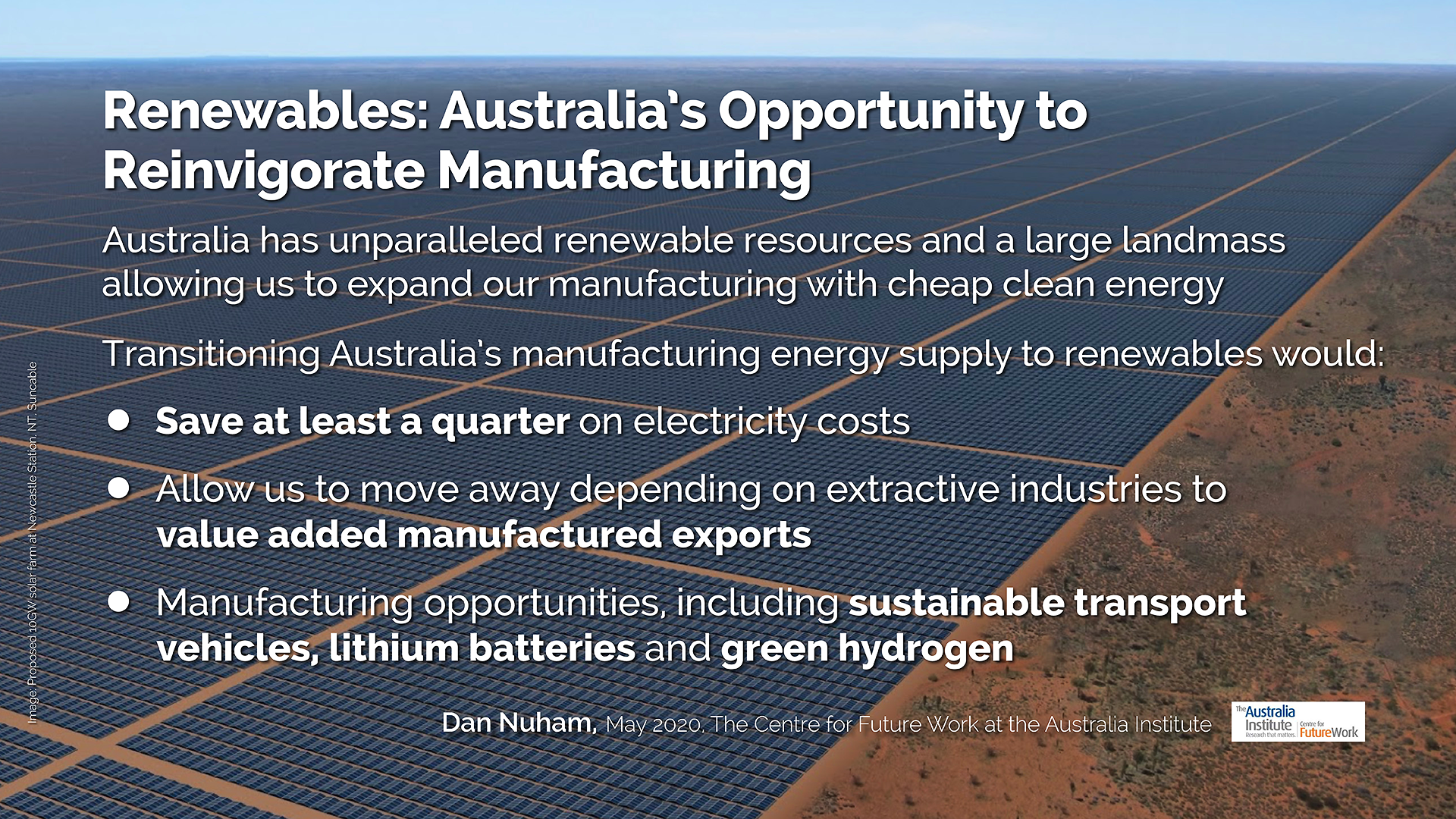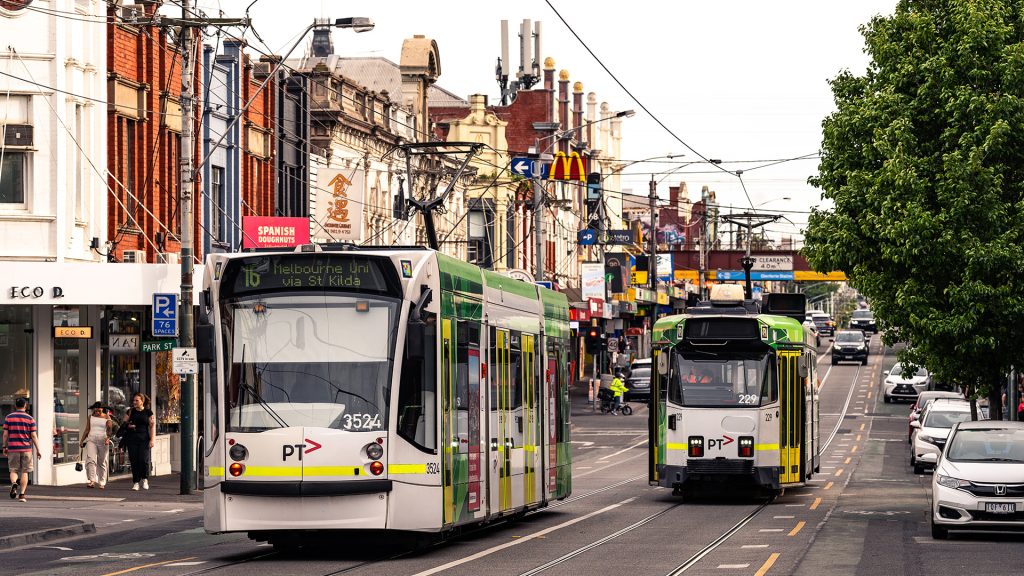Australia’s Choice: Carbon Crunch or Renewables Superpower?

JACK MEEHAN
Five years after the Paris Agreement we have failed to begin to reduce emissions, with the world facing the possibility of societal collapse within our lifetimes. In Australia, with unparalleled renewable resources, we fail to move even though we could become a clean energy superpower.
Why are we still clinging to fossil fuels?
A warning on climate and the risk of societal collapse
Over 250 scientists and academics including Prof Gesa Weyhenmeyer and Prof Will Steffen argue, in a letter in the Guardian, that “it is time to have these difficult conversations” about the threat of “societal collapse” a “credible scenario this century.”
“Only if policymakers begin to discuss this threat of societal collapse might we begin to reduce its likelihood, speed, severity, harm to the most vulnerable – and to nature.”
“The year 2020 is crucially important for another reason, one that has more to do with physics than politics. When it comes to climate, timing is everything. According to an April report (prepared by Carbon Tracker in London, the Climate Action Tracker consortium, the Potsdam Institute for Climate Impact Research in Germany and Yale University in New Haven, Connecticut), should emissions continue to rise beyond 2020, or even remain level, the temperature goals set in Paris become almost unattainable.”

2017, Figueres et al, letter in Nature: Three years to safeguard our climate
“The year 2020 is crucially important for another reason, one that has more to do with physics than politics. When it comes to climate, timing is everything. According to an April report (prepared by Carbon Tracker in London, the Climate Action Tracker consortium, the Potsdam Institute for Climate Impact Research in Germany and Yale University in New Haven, Connecticut), should emissions continue to rise beyond 2020, or even remain level, the temperature goals set in Paris become almost unattainable.”

It’s now 2020 and there is little sign that global climate policies are on track to bend the curve on emissions. Scott Morrison and Angus Taylor have ignored Figueres and Schellnhuber’s dire warning and are promoting gas expansion, leaving any climate progress to the States.
We are at the brink.

Approaching two degrees could risk everything. We must heed the lessons in the influential 2018 “Hothouse Earth” paper and rapidly reduce emissions. The later we leave this the more likely we are to create an “inhospitable” planet.
“But we must never forget that we are in a unique situation with no precise historic analogue. The level of greenhouse gases in the atmosphere is now greater, and the Earth warmer, than human beings have ever experienced.”
– Prof Hans Joachim Schellnhuber

The landmark IPCC report on 1.5°C pathways drew a line in the sand on fossil fueled climate damage. Considering over 6000 reports and papers, leading climate scientists warned in 2018 there were only a dozen years for global warming to be kept to a maximum of 1.5C, “beyond which even half a degree will significantly worsen the risks of drought, floods, extreme heat and poverty” for hundreds of millions of people, reports Jonathon Watts, The Guardian’s global environment editor.

“We have presented governments with pretty hard choices. We have pointed out the enormous benefits of keeping to 1.5C, and also the unprecedented shift in energy systems and transport that would be needed to achieve that,” said Jim Skea, a co-chair of the working group on mitigation. “We show it can be done within laws of physics and chemistry. Then the final tick box is political will.”
“I tell you what – our policies will be set here in Australia.”
Scott Morrison, refusing to commit to net zero by 2050
Accelerating global net zero commitments put pressure on Australia
Three of Australia’s major trading partners have committed to net zero emissions commitments by 2050 (Korea and Japan) and 2060 (China) in late 2020, possibly “the biggest shift in international climate politics since the signing of the Paris agreement five years ago”. This announcement will put pressure on Australia’s long term exports, given that Korea, Japan and China buy 75% of Australia’s shipped thermal coal, 50% of the coking coal for steel production, and 87% of its liquefied natural gas.
Adam Morton reports “In a call on Tuesday night, Morrison turned down his British counterpart, Boris Johnson, when asked to sign up to a 2050 net zero commitment” refusing to raise Australia’s inadequate targets.
Ursula Fuentes, former head of a German climate policy unit, says “Australia needs to start talking about an economic transformation, and introducing policies that will support that transformation, or it will be left behind”

“There is a large gap between what countries have committed to, in terms of future emission reductions, and what would be needed to meet the Paris Agreement targets” reports Carbon Brief’s Zeke Hausfather. Current countries commitments would leave global emissions in 2030 “some 12-15bn tonnes of CO2 (GtCO2) short of what is needed to put the world on track to limit warming below 2C, and 29-32GtCO2 short for 1.5C.”

Hausfather reminds us that “there is relatively little carbon budget remaining for warming to be limited to 1.5C.” Writing in 2019 he says that with only around 340GtCO2 – there would only be “eight years of current emissions remaining, that can be emitted before the world passes 1.5C warming”.
There is relatively little carbon budget remaining for warming to be limited to 1.5C. With 2019 emissions widely expected to be similar to those in 2018, there will be only around 340GtCO2 – or 8 years of current emissions – remaining, that can be emitted before the world passes 1.5C warming.
“If emissions had peaked and begun to decline after the year 2000, the 1.5C target would have been much easier to achieve”
“Limiting warming to below 1.5C starting in 2019, without net-negative emissions, would require a 15% cut each year through to 2040.”
“If emissions continue at current levels for another few years, then the only way to limit warming to below 1.5C in the absence of net-negative emissions would be to immediately cut all global emissions to zero.
Each year that passes without global emission reductions puts the 1.5C target further out of reach.”

Morrison’s handpicked Covid Commission favours not just public spending on gas industry infrastructure, but also underwriting supply, reports Adam Morton.
“A leaked draft report by a manufacturing taskforce advising the National Covid-19 Coordination Commission (NCCC) recommends the Morrison government make sweeping changes to “create the market” for gas and build fossil fuel infrastructure that would operate for decades.
Its vision includes Canberra underwriting an increased national gas supply”

Australia, second worst in the world on climate action, outdone only by Brunei, has emerged as “an international laggard with respect to its response to climate change and has been accused of actively obstructing progress towards global cooperation to reduce greenhouse gas emissions, including through United Nations climate change talks.” writes Michael Mazengarb for Renew Economy. Australia’s ranking continues to be “weighed down by high fossil fuel use and lacklustre emissions reduction targets.”
In the 2020 edition of the Sustainable Development Report, Australia’s score for “climate action” saw it rank “second last, with oil and gas heavy Brunei the only country that received a worse score.”
Australia scored “lower than fossil fuel heavy countries, including Kuwait, the United Arab Emirates, Norway and Qatar.”

Greta Thunberg has released a new call to action.
“We are still speeding in the wrong direction. The five years following the Paris agreement have been the five hottest years ever recorded and, during that time, the world has emitted more than 200bn tonnes of CO2.” writes Damian Carrington, for the The Guardian.
“Distant hypothetical targets are being set, and big speeches are being given. Yet, when it comes to the immediate action we need, we are still in a state of complete denial, as we waste our time, creating new loopholes with empty words and creative accounting.”
Greta explains that what is needed for many people to become aware. “There is hope … we are the hope – we, the people.”

“The Morrison government trembles at the thought of the Paris agreement’s goal of achieving zero net carbon emissions by 2050. All it can see is the need for higher taxes and the loss of jobs in coal mining. Garnaut, by contrast, sees a golden opportunity for us to shift from an industry in terminal decline to a new set of industries with bright prospects in the low-carbon world that’s coming.” writes Ross Gittens, for the Sydney Morning Herald.
Garnaut foresees that, if we rise to the challenge of climate change, we “will emerge as a global superpower in energy, low-carbon industry and absorption of carbon in the landscape”.

“Australian manufacturers would save significantly—in the order of one-quarter or more—on their electricity costs by switching their supply entirely to renewables. That would mean greater international competitiveness and more high-quality Australian manufacturing jobs.” writes Dan Nahum, in the Powering Onwards Report, May 2020, for The Centre for Future Work at the Australia Institute.
“If Australia’s current coal- and gas- fired electricity was replaced with renewables (even allowing for six hours of pumped hydro storage), rather than more fossil fuel generation, the Australian manufacturing sector could save $1.6 billion per year.. (23%)” and as the cost of renewable energy production falls, the savings would increase to “$2.2 billion per year”, or “33% of their energy bills”.
Nahum reiterates that despite increased renewables uptake by manufacturers who are “developing their own dedicated renewable energy supplies, contracting for renewable power through power purchase agreements, and developing value-added products and technologies to further leverage the coming boom in renewable power”, supportive policy measures by government is needed to accelerate the clean energy transition, allowing “manufacturers to make the most of Australia’s unique endowment of renewable energy.”
Community engagement key to climate action in upcoming Council elections
Councils are the layer of government closest to our daily lives, and they have the power to help us to go electric, improve our health, transport and protect biodiversity and the environment. It's time to step up - interviews with sitting Councillors and candidates before the October 2024 elections.
Gas Health Impacts with Dr Genevieve Cowie
JACK MEEHANWhat risks do we run with household gas? Check out this highlights video from Dr Genevieve Cowie, Convenor of Doctors for the Environment Australia’s Research, Education and Advocacy Committee and public health physician. You can watch the video here. Dr...
It’s time to go electric
JACK MEEHANIt has been a rewarding experience to work with Electrify Boroondara to create engaging promotional videos and help grow the group's profile. Electrify Boroondara Expo Electrify Boroondara is hosting a huge electrification Expo today, with experts...



